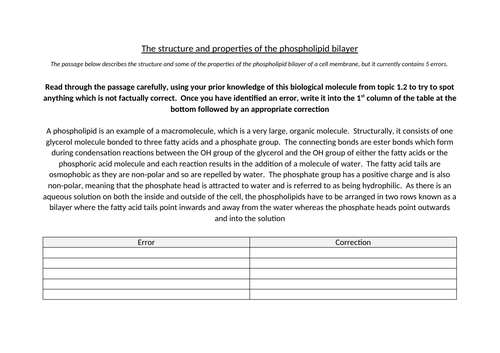





This fully-resourced lesson describes the structure of the cell surface membrane and references Singer and Nicholson’s fluid mosaic model. The detailed and engaging PowerPoint and accompanying resources have been designed to cover specification point 4.2 (i) of the Edexcel A-level Biology B specification and also makes clear links are made to related topics such as the binding of hormones as covered in topic 9 and the electron transport chain as covered in topic 5.
The fluid mosaic model is introduced at the start of the lesson so that it can be referenced at appropriate points throughout the lesson. Students were introduced to phospholipids in topic 1 and an initial task challenges them to spot the errors in a passage describing the structure and properties of this molecule. This reminds them of the bilayer arrangement, with the hydrophilic phosphate heads protruding outwards into the aqueous solutions on the inside and the outside of the cell. In a link to some upcoming lessons on the transport mechanisms, the students will learn that only small, non-polar molecules can move by simple diffusion and that this is through the tails of the bilayer. This introduces the need for transmembrane proteins to allow large or polar molecules to move into the cell by facilitated diffusion and active transport. Proteins that act as receptors as also introduced and an opportunity is taken to make a link to topic 9 so that students can understand how hormones or drugs will bind to target cells in this way and cause the release of cAMP on the interior of the cell. Moving forwards, the structure of cholesterol is covered and students will learn that this hydrophobic molecule sits in the middle of the tails and therefore acts to regulate membrane fluidity. The final part of the lesson challenges the students to apply their newly-acquired knowledge to a series of questions where they have to explain why proteins may have moved when two cells are used and to suggest why there is a larger proportion of these proteins in the inner mitochondrial membrane than the outer membrane.
Get this resource as part of a bundle and save up to 36%
A bundle is a package of resources grouped together to teach a particular topic, or a series of lessons, in one place.
Topic 4: Exchange and transport (Edexcel A-level Biology B)
The wide variety of tasks that are written into the 18 lesson PowerPoints and accompanying resources that are included in this lesson bundle will engage and motivate the students whilst covering the detailed content of topic 4 of the Edexcel A-level Biology B specification (Exchange and transport). The following specification points are covered by these lessons: * Understand how the surface area to volume ratio affects the transport of molecules in living organisms * Understand why organisms need a mass transport system and specialised gas exchange surfaces as they increase in size * The structure of the cell surface membrane * Passive transport is brought about by diffusion and facilitated diffusion * Passive transport is brought about by osmosis * Understand how the properties of molecules affects how they are transported * Large molecules are transported in and out of cells by endocytosis and exocytosis * The process of active transport * The phosphorylation and hydrolysis of ATP * Understand how insects, fish and mammals are adapted for gas exchange * The structure of the heart, arteries, veins and capillaries * The advantages of the double circulatory system * The sequence of events of the cardiac cycle * The myogenic stimulation of the heart * Interpreting ECG traces * The role of platelets and plasma proteins in the sequence of events leading to blood clotting * The structure of haemoglobin in relation to its role in the transport of respiratory gases * The Bohr effect * The dissociation curve of haemoglobin * The significance of the oxygen affinity of foetal haemoglobin * The similarities and differences between the structure and function of haemoglobin and myoglobin * The formation and reabsorption of tissue fluid * Know that tissue fluid that is not reabsorbed is returned to the blood via the lymph * The structure of the xylem and phloem in relation to their role in transport * The movement of water by the apoplastic and symplastic pathways * The cohesion-tension model Hours and hours has gone into the intricate planning of all of these lessons and the quality can be sampled by downloading the following lessons which have been uploaded for free: Surface area to volume ratio ATP, active transport, endocytosis and exocytosis Structure of the heart, arteries, veins and capillaries Double circulatory system Apoplastic and symplastic pathways
Topic 4.2: Cell transport mechanisms (Edexcel A-level Biology B)
This bundle of 4 fully-resourced lessons have been planned to include a wide variety of tasks which will engage and motivate the students whilst covering the following points as detailed in topic 4.2 of the Edexcel A-level Biology B specification: * The structure of the cell surface membrane, with reference to the fluid mosaic model * Passive transport is brought about by diffusion and facilitated diffusion * Passive transport is brought about by osmosis * The relationship between the properties of molecules and the method by which they are transported * Large molecules can be transported in and out of cells by endocytosis and exocytosis * The process of active transport and the role of ATP * The phosphorylation of ADP and the hydrolysis of ATP If you would like to sample the quality of the lessons in this bundle, then download the ATP & active transport lesson as this has been shared for free
Something went wrong, please try again later.
This resource hasn't been reviewed yet
To ensure quality for our reviews, only customers who have purchased this resource can review it
Report this resourceto let us know if it violates our terms and conditions.
Our customer service team will review your report and will be in touch.